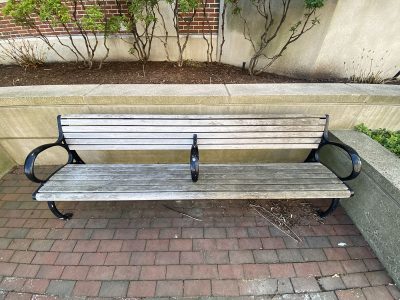Hostile architecture in Boston continues to negatively affect those experiencing homelessness in the city.

Last month, activists identifying themselves as “Shlubs for Housing” on Twitter — a name co-opted from a since-changed Universal Hub headline — removed armrests that could prevent someone from lying down on benches in several Cambridge train stops.
“The list of accessibility issues with the MBTA is long,” the group wrote in a tweeted statement. “As a particularly serious example, it took the MBTA two years to repair the broken elevator at Central Square Station — yet it took days for them to install hostile architecture in T stations across Cambridge.”
Robert Rosenberger, an associate professor of philosophy at Georgia Institute of Technology, has written extensively on anti-homeless architecture or “hostile architecture,” which he defined as “a design that targets a specific vulnerable population to push them out of an area.”
Common examples of hostile architecture include armrests that divide benches — like those the Shlubs for Housing removed — spikes on wide ledges, sprinklers that water sidewalks at night, green spaces turning into cobblestone and even certain trash cans, Rosenberger said.
“One of the ones that I’d like to point out too, that I feel like is not part of the discussion, is trash cans that are designed so that you can’t pick out of them,” Rosenberger said. “You’ll see that, especially in cities where you can return aluminum cans and stuff for money, you’ll find that trash cans are built in such a way that you can’t reach in.”
Determining the goal of placing these types of structures isn’t always clear, Rosenberger said.
For example, the bench armrests were installed to comply with the Americans With Disabilities Act, according to a statement by the MBTA. But eventually, Rosenberger said they push vulnerable populations, especially unhoused populations, out of shared public spaces and out of view.
“Sometimes it seems like the goal ultimately is to have people forget about the problem of homelessness altogether,” Rosenberger said.
A 2018 study by Caitlin Carey, a postdoctoral scholar at the Benioff Homelessness and Housing Initiative at the University of California San Francisco, found that hostile architecture in Boston is more likely to appear farther away from homeless shelters.
The report also found that the behaviors most commonly targeted by hostile architecture include sitting, reclining, resting and sleeping.
“Once you know that it exists, you start to notice it everywhere,” Carey said. “It’s really hard to say whether there’s an actual increase or whether we’re just paying more attention to it.”
She added that hostile architecture could make unhoused people feel “rejected by the city.”
“While it might be more subtle to some people who are in housing, it’s definitely not subtle to people experiencing homelessness,” Carey said. “They’re very heavily impacted by this.”
One solution to combat this issue is through inclusive design, Carey said.
“It’s really just considering the needs of all people who are using the space,” she said.
Carey suggested another solution could be increased representation in policy-making.
“Including the voices of people experiencing homelessness when you’re designing public spaces [could help],” she said. “They’re part of the public as well, and they need to have a public space that works for them.”
Shlubs for Housing listed three demands for reparations at the end of their statement: removal of all hostile architecture from MBTA stations, removal of all hostile architecture from the City of Cambridge and its community and that the city provide housing for all residents experiencing homelessness.
Carey said the removal of the armrests may have increased public awareness of hostile architecture and helped bring it into the public dialogue.
“The people in power, the politicians and everyone, is starting to pay attention to the issue,” she said. “Hopefully that leads to some positive outcome.”























































































































John Sand • Apr 7, 2021 at 11:22 am
The privilege of the Shlubs is pretty notable. The whole initiative was clearly designed by people who’ve never been catcalled, threatened or harassed by the many unhoused people with significant behavioral problems. Inviting them into public spaces like T stops inevitably makes those spaces hostile and unsafe for women, in particular, and specially at night.